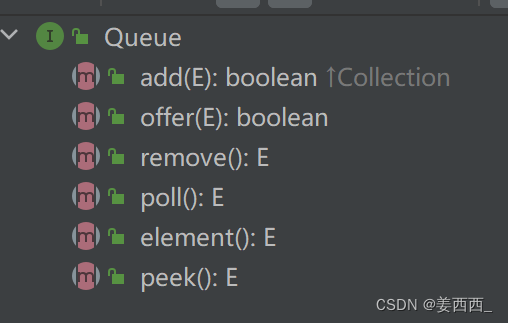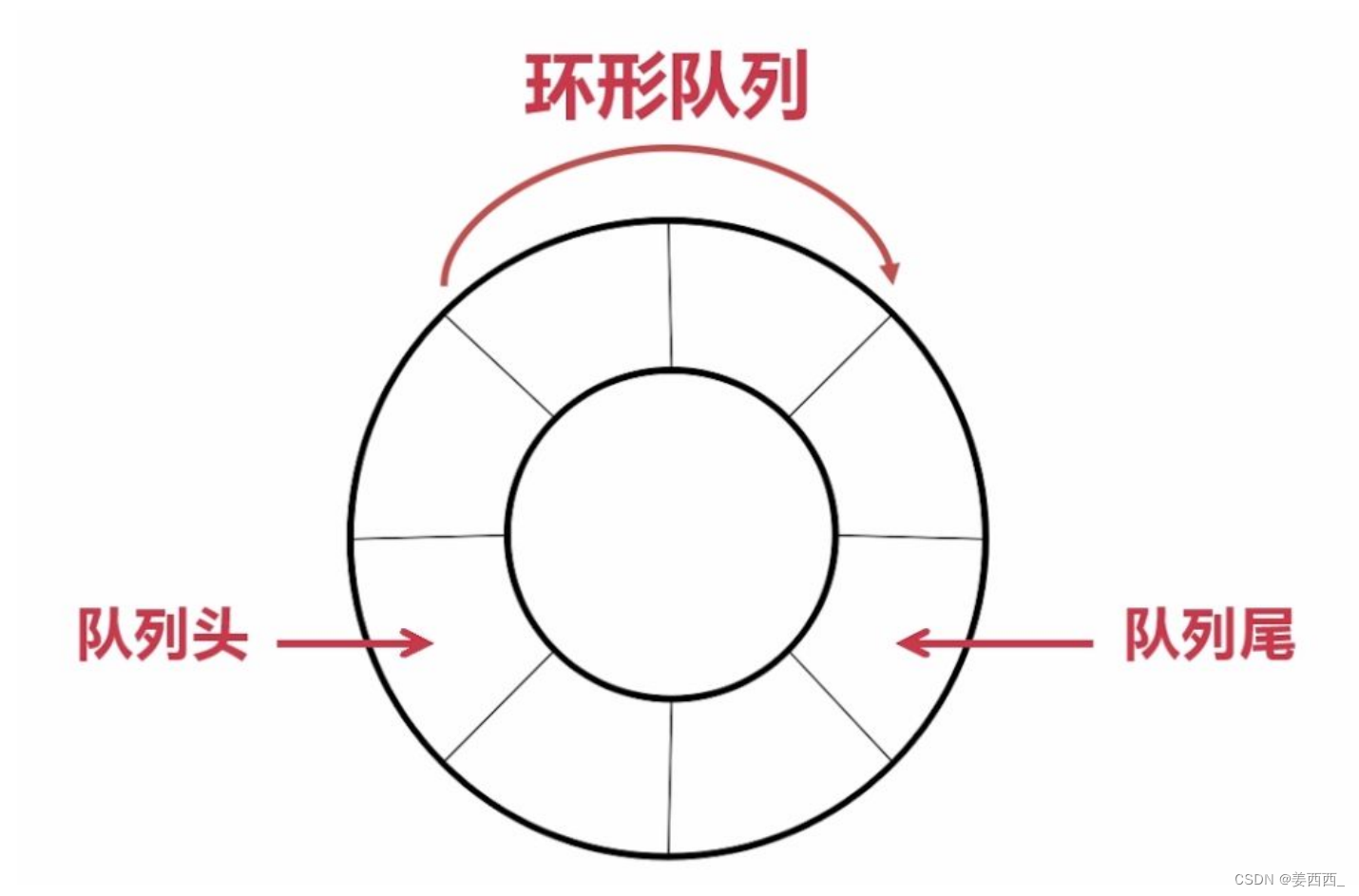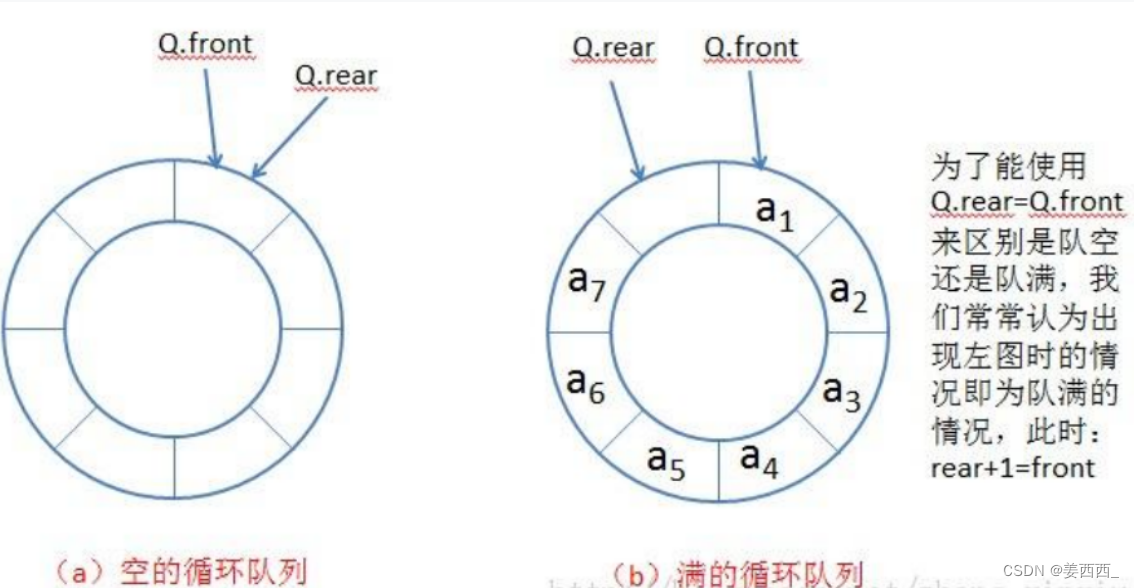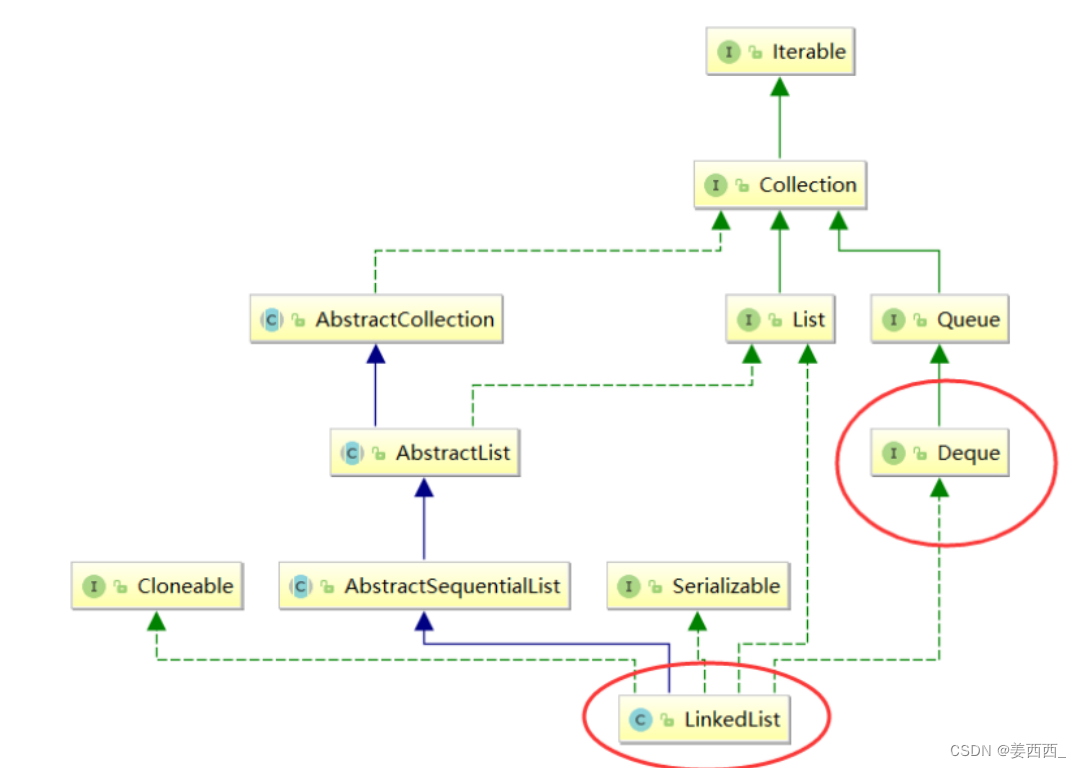目录
一. 概念
二. 队列的使用
三. 队列模拟实现
四. 循环队列
五. 面试题
一. 概念
队列 :只允许在一端进行插入数据操作,在另一端进行删除数据操作的特殊线性表,队列具有先进先出 FIFO(First In First Out) 入队列:进行插入操作的一端称为 队尾( Tail/Rear ) 出队列:进行删除操作的一端称为 队头 ( Head/Front )

在 Java 中, Queue 是个接口,底层是通过链表实现 的。


在Queue接口的方法里, 我们看到有add remove element 这些是继承于Collection接口的, 而offer poll peek是接口本身的,他们的使用效果基本一致
二. 队列的使用

注意:Queue是个接口,在实例化时必须实例化LinkedList的对象,因为LinkedList实现了Queue接口。
public static void main ( String [] args ) {Queue < Integer > q = new LinkedList <> ();q . offer ( 1 );q . offer ( 2 );q . offer ( 3 );q . offer ( 4 );q . offer ( 5 ); // 从队尾入队列System . out . println ( q . size ());System . out . println ( q . peek ()); // 获取队头元素q . poll ();System . out . println ( q . poll ()); // 从队头出队列,并将删除的元素返回if ( q . isEmpty ()){System . out . println ( " 队列空 " );} else {System . out . println ( q . size ());}}
三. 队列模拟实现
队列中既然可以存储元素,那底层肯定要有能够保存元素的空间,通过前面线性表的学习了解到常见的空间类型有两种:顺序结构 和 链式结构 。显然实现队列用链式结构更好, 但是用单链表还是双向链表呢?
如果使用单链表, 从队尾进, 想要找到队尾, 则需遍历一遍链表, 或需要用last指针指向队尾, 从队头出, 则需将头结点向后移动
显然, 使用双向链表更加方便.
(LinkedList 可以看做: 双向链表 栈 队列)
public class MyQueue {static class ListNode{public int val;public ListNode prev;public ListNode next;public ListNode(int val){this.val = val;}}public ListNode head;public ListNode last;//入队public void offer(int val){ListNode node = new ListNode(val);if(head == null){head = last = node;}else{last.next = node;node.prev = last;last = node;}}//出队public int poll(){if(empty()){return -1;}int val;if(head.next == null){val = head.val;head = null;last = null;return val;}val = head.val;head = head.next;head.prev = null;return val;}public boolean empty(){return head == null;}public int peek(){if(head ==null){return -1;}return head.val;}
}四. 循环队列
实际中我们有时还会使用一种队列叫循环队列。如操作系统课程讲解生产者消费者模型时可以就会使用循环队列。
环形队列通常使用数组实现。

数组下标循环的小技巧

队尾指针向后:
rear = (rear + 偏移量) %array.length
队尾指针向前:
rear = (rear + array.length - 偏移量) %array.length
如何区分空与满
1. 通过添加 size 属性记录
2. 保留一个位置, 浪费一个空间
2. 保留一个位置, 浪费一个空间

设计一个循环队列 链接
class MyCircularQueue {public int[] elem;public int front;public int rear;public MyCircularQueue(int k) {elem = new int[k+1];}//入队public boolean enQueue(int value) {if(isFull()){return false;}elem[rear] = value;rear = (rear+1)%elem.length;return true;}//删除队头元素public boolean deQueue() {if(isEmpty()){return false;}front = (front + 1)%elem.length;return true;}//得到队头元素public int Front() {if(isEmpty()){return -1;}return elem[front];}//得到队尾元素public int Rear() {if(isEmpty()){return -1;}int index = (rear + elem.length - 1)%elem.length;return elem[index];}public boolean isEmpty() {return front == rear;}public boolean isFull() {return (rear + 1)%elem.length == front;}
}五. 双端队列
双端队列( deque )是指允许两端都可以进行入队和出队操作的队列, deque 是 “double ended queue” 的简称。
那就说明元素可以从队头出队和入队,也可以从队尾出队和入队。

Deque是一个接口,使用时必须创建LinkedList的对象。

在实际工程中,使用 Deque 接口是比较多的,栈和队列均可以使用该接口。
Deque<Integer> stack = new ArrayDeque<>();// 双端队列的线性实现Deque<Integer> queue = new LinkedList<>();// 双端队列的链式实现
五. 面试题
1. 用队列实现栈 链接
思路:一个队列是不能实现栈的, 需要用两个队列
1. 入栈, 当两个队列都为空时, 放在第一个队列里
2. 再次入栈时, 放在不为空的队列
3. 出栈时, 出不为空的队列, 出size-1个元素, 剩下的一个就是要出栈的元素
代码:
class MyStack {private Queue<Integer> qu1;private Queue<Integer> qu2;public MyStack() {qu1 = new LinkedList<>();qu2 = new LinkedList<>();}public void push(int x) {if(empty()){qu1.offer(x);return;}if(!qu1.isEmpty()){qu1.offer(x);}else{qu2.offer(x);}}public int pop() {if(empty()){return -1;}if(!qu1.isEmpty()){int size = qu1.size();for(int i = 0;i < size-1;i++){qu2.offer(qu1.poll());}return qu1.poll();}else{int size = qu2.size();for(int i = 0;i < size-1;i++){qu1.offer(qu2.poll());}return qu2.poll();}}public int top() {if(empty()){return -1;}if(!qu1.isEmpty()){int size = qu1.size();for(int i = 0;i < size-1;i++){qu2.offer(qu1.poll());}int tmp = qu1.peek();qu2.offer(qu1.poll());return tmp;}else{int size = qu2.size();for(int i = 0;i < size-1;i++){qu1.offer(qu2.poll());}int tmp = qu2.peek();qu1.offer(qu2.poll());return tmp;}}public boolean empty() {return qu1.isEmpty() && qu2.isEmpty();}
}2. 用栈实现队列 链接
思路:一个栈不能实现队列, 需要两个栈
1. 入队, 把数据放在第一个栈
2. 出栈, 出第二个栈的栈顶元素即可, 如果第二个栈为空, 将里面的所有元素放到第二个栈
3. 当两个栈都为空时, 说明模拟的队列为空
class MyQueue {private Stack<Integer> s1;private Stack<Integer> s2;public MyQueue() {s1 = new Stack<>();s2 = new Stack<>();}public void push(int x) {s1.push(x);}public int pop() {if(empty()){return -1;}if(s2.isEmpty()){while(!s1.isEmpty()){s2.push(s1.pop());}}return s2.pop();}public int peek() {if(empty()){return -1;}if(s2.isEmpty()){while(!s1.isEmpty()){s2.push(s1.pop());}}return s2.peek();}public boolean empty() {return s1.isEmpty() && s2.isEmpty();}
}





)

快速访问资源)


——UDP快速入门)



spring boot 使用RSA非对称加密,前后端传递参数加解密)




